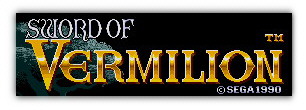
 |
|
Lost in the midst of many higher-profile Genesis RPGs (like the Phantasy Star and Shining series) is an obscure action-RPG known as Sword of Vermilion. Released back in 1990, it displayed many features that would not become standards until many years later - a magic system that did not involve merely leveling up to learn new spells, unique battle mechanisms, and a 3-D viewpoint. Sword of Vermilion actually features three different viewpoints. While travelling the world map or exploring dungeons, you see the world from a psuedo-3-D perspective (2-D sprites scaled to look 3-D). Some of the dungeons grow quite large, and are impossible to navigate unless you acquire the map tucked away in a chest somewhere in each area. All the chests are located at the ends of dead-end passages, and do not materialize until you reach the very end of the passage. This forces you to explore every inch of each cave and encounter numerous enemies in the process. Looking back on such a system, it seems incredibly tedious, but at the time, it seemed -- and was -- enjoyable. Whenever the numerous monsters do appear, you switch to the second perspective (also used in towns), a top-down view of your sole playable character and his foes. As most of the enemies are far more powerful than you, your only asset is your feet - quick movement and careful navigation through the hordes of enemies are the keys to winning. You can also draw from your arsenal of magic, but only one spell may be equipped at a time. Seven reserve spellbooks can also be carried; you can choose the active one between fights. Occasionally, you'll also face a boss, all of whom are fought from a side-scrolling perspective that almost resembles a fighting game. Sword of Vermilion also featured an excellent soundtrack -- by the standards of the day, at least. Several of the tunes are quite catchy, and apparently Sega thought so too -- the game's manual includes detailed instructions explaining how to use the game's sound test to record an audio tape of the music. Odd, perhaps, but it's the thought that counts. The plot, if you can call it such, is poor even by the standards or 1990. It encompasses a tension-filled chain of events that sees the hero journeying to a town, where someone gives him a clichéd task -- Expose The Fake King, Rescue The Trapped Miners, etc. Upon completing this nail-biting mission (which always invovles journeying to one of the identical-looking caves), the hero is given the key that allows him to progress on to the next of 14 areas, and so on, until he reaches the final boss and kills him. In one particularly ridiculous scenario, a king asks you (for no apparent reason) to bring him a crystal from a nearby cave. You do so, and the king promptly asks you to fetch a second crystal from a different cave. That crystal earns you a new mission -- yes, to find and retrieve a third (and final) crystal from yet another cave. Will the excitement never end? To be fair, there are a few deviations from this routine -- such as the unusual method in which you acquire the game's titular weapon. In one town midway through the game, you encounter a shopkeeper who offers to sell you one of three strange items, all of which cost an undisclosed amount of money. Buying one will prompt the shopkeeper to take all your money, claim you don't have enough, and kick you out of the shop. He finally pays you back much later in the game by giving you the game's strongest weapon, the Sword of Vermilion -- the creation of which required a great deal of money that only you could offer. Just in case somebody might not understand this sequence of events, the strategy guide included with the game offers some helpful advice enclosed in a important-looking black box. "Something extremely important happens in this shop... this is a very important event in the game," it informs you. "Resist the temptation to reset the game and start again from your last saved position... think of it as a way to build character." One of the other rare distinctive moments comes slightly earlier in the game, when you are given the mighty Sanguios spellbook by a stranger in a cave. Now you can heal yourself completely for a measly 2 MP. It seems almost too good to be true. And it is -- the spellbook is actually stolen from the king, who confiscates it when you speak with him. To prove your innocence, you must return to the cave and defeat the disguised demon who sold it to you. These moments stood out in 1990, when such sequences rarely appeared. Now, however, they are hardly enough to carry a game. Some early RPGs, such as the Final Fantasies and the Phantasy Stars, have aged gracefully -- they're still as much fun now as they were originally. Sadly, this is not the case with Sword of Vermilion. Anything it once offered has been eroded by the passage of time, and by today's standards, the game can only be considered bad. But those who picked up the title when it first appeared will remember Sword of Vermilion as a game ahead of its time in many ways. Retrospective by Fritz Fraundorf, GIA |
|
|||||||||||||||||||||||||||||||||||||||
